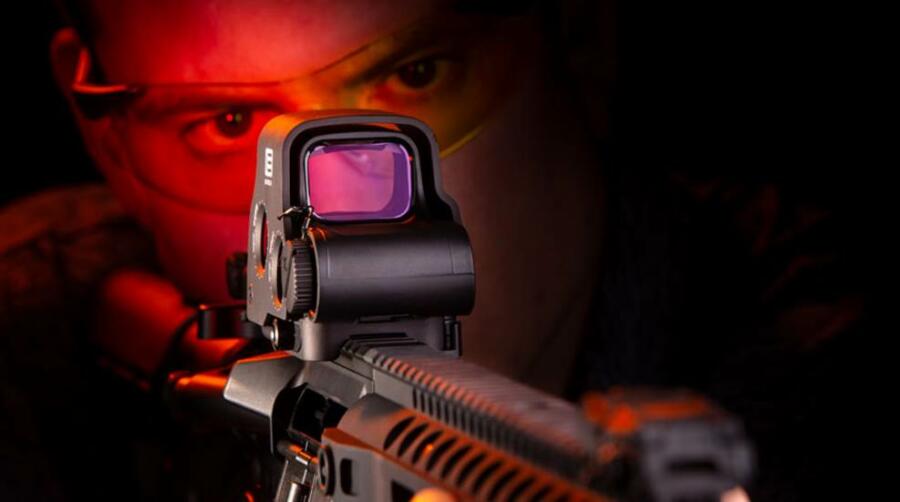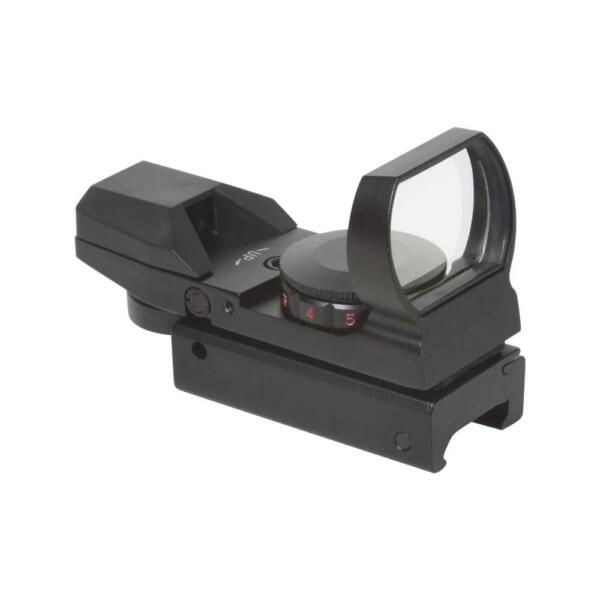Reflex sights have become a fixture on pistols and rifles across the civilian market. They’re lightweight and easy to use and can improve your accuracy in high-stress situations. What, then, is the difference between reflex sights and red dot or holographic sights? What makes reflex sights ideal over similar light-based gunsights?
Let’s look at what makes reflex sights a great option for hunters and competitive shooters alike. We’ll see how they work and their advantages over other gun sights.
How Do Reflex Sights Work?
Modern red dot reflex gun sights trace their lineage to the early 1900s, with Air Forces adopting the laser-to-glass reticle design for their fighters. Modern reflex sights are actually a type of red dot sight. These sights utilize a powerful LED light located at the back of the optic. This projects a reticle image onto a concave semi-transparent lens. This then reflects the reticle into the user’s eye.
These reticles can range from a simple red dot to a dot inside a ring with notches, similar to a holographic sight. Manufacturers give users plenty of reticle options. Because of how simple the internal mechanisms are, reflex sights tend to be much smaller and lower-profile than their counterparts. They are light and work well in close quarters.
They also offer unparalleled eye relief, allowing you to aim from any position as long as you can see the reticle. Users do not suffer from parallax problems or need to make long-range adjustments. By projecting simple shapes, reflex sights draw the focus of your eye to the target. This makes shooting reflexive, as you instinctively know where to aim and hit when using this scope.
Types of Reflex Sights

Red dot sights once belonged exclusively on military hardware like artillery and aircraft because of how big they used to be. Ironically, they are now some of the smallest sights on the market. There are two main types of reflex sights: Tube-style and open-hooded-style reflex sights. Let’s look at what makes them different.
1. Tube Style
Tube reflex scopes offer the same feel and ergonomics as normal scopes but with a simple red dot reticle instead of the mil-dot crosshairs found on sniper scopes. These tubes are believed to better focus light into the eyepiece and your eye. They allow you to see your target clearly and are more reliable in chaotic situations.
Military and law enforcement personnel may prefer this version because it doesn’t fog, and the tube allows you to see your reticle even under harsh sunlight.
2. Open (Exposed) Style
Open-style hooded reflex sights are the more recognizable style of red dot sights, being used in military circles since the early 1990s. They are the default type of reflex sights. These sights are excellent for civilians. They can be used for competitions, small game hunting, self-defense, and concealed carry. They work in a variety of situations.
These models are extraordinarily lightweight, cheap, and easy to mount. You can include them in your everyday carry loadout or use them as emergency sights when your main goes down.
Difference Between Red Dot and Reflex Sights
To define what a reflex sight is, we must first differentiate it from its origin line: red dot sights, as well as prism and holographic sights.
Holographics are more advanced than ordinary red dots because they use mirrors and lasers to project a reticle that enters your eye through the rear glass. It does not use the front glass as reflex sights do. This complex system of reticles and holographic grating makes holographic sights bulkier and heavier than red dots, which are straightforward and lightweight. The light bounces off the glass and into your eye directly.
Meanwhile, prismatic red dots reflex and fold light into the eyepiece. They function more like traditional sights than other red dots and are much larger than reflex sights.
Compared to the previously-mentioned red dot types, reflex sights are the lightest, most simplistic, and smallest options available. They are the default sights people picture when the words “red dot sight” come to mind.
How To Aim with Reflex Sights
The main benefit of using reflex red dot sights is that aiming is a breeze with this type of optic. It’s designed to be as unobstructed as possible, giving users the widest sight picture possible in the smallest package. Aiming is fairly straightforward with reflex sights. You will simply need to bring the sight in line with your dominant eye and plant the reticle directly on your target.
Once the dot is placed at the center of your target, it’s time to fire. There’s no need to worry about magnifications or parallax. Where you aim is where you hit. Red dot reticles are designed to draw your eye to the center of the dot. This makes it easy to transition from one target to another. You will not fumble or struggle to readjust your aim.
Benefits of Reflex Sights
Reflex red dot sights outshine holographic and prism red dots for various reasons. Let’s go through some of them below.
1. Lightweight
The no-nonsense design of reflex sights allows them to be as lightweight as possible. They keep a low profile, with the exposed-style sights having only a single pane of glass. This allows reflex sights to be as small as possible. Many models like those made by Holosun can be mounted on top of a pistol’s rear sights without an external rail mount.
They add the smallest amount of weight possible and offer an incredibly-small profile. They’re so small that they can even be mounted on top of other scopes like ACOGs as backup sights.
2. Rapid Target Acquisition
Reflex sights offer users a small reticle with a relatively-large sight picture. This allows you to see your next target before your dot even leaves your current one. This allows you to fire rapidly and maneuver from target to target without losing a bead on where your targets are. This makes them excellent for self-defense, where you may deal with multiple intruders.
3. Sight Alignment
Reflex sights work well on pistols and rifles because they do not require significant eye relief and don’t need to be close to your eye for you to see your aiming point. In general, you will only need to align your eye with the reticle for your shot to be accurate. There’s no need to blur your vision like with iron sights or close one eye like with scopes.
4. Ease of Use
Unlike sniper scopes that require windage and elevation adjustments, reflex sights allow you to rely on your reflexes. You can pull the trigger the moment you see the dot land on your target. The reticle is projected by a single LED light and reflected into your eye. You don’t need to make any adjustments to hit your target. Simplicity is what makes reflex sights so exceptional.
Conclusion
Reflex sights are red dot sights that allow users to shoot with both eyes open. Combined with exceptional eye relief, they allow competition shooters to go from strength to strength.
They are simple yet precise machines that can turn beginners into capable, competent shooters. They allow you to find your targets and hit them with ease every time.
Also read: 3 Assets Atlanta To Trade for Xander Bogaerts: Rumors Revealed
























































